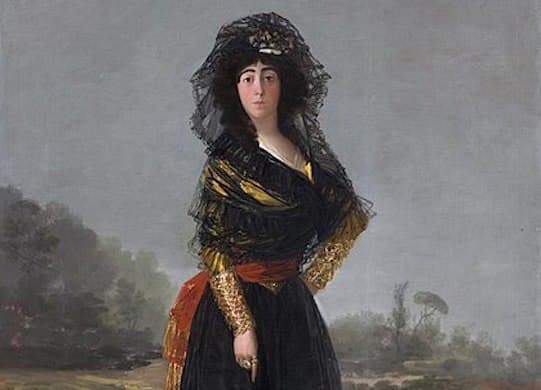The Duchess of Alba With Her Clothes On and Other Treasures of the Hispanic Society
To see the Goya would be, alone, worth the trip to West 155th Street in Manhattan for the temporary exhibition.

Archer Milton Huntington, the adopted son of railroad magnate Collis Huntington, did not want to follow in the footsteps of his ambitious stepfather. Instead he struck out on his own with some family funds and founded the Hispanic Society Museum and Library, which opened to the public in 1908 on property that had been owned by the Audubon family.
Today most of the original buildings are being remodeled, and a temporary space has opened on the lower floor with an exhibition of some highlights of the permanent collection, which includes 1,000 sculptures, 175,000 photographs, 250,000 books, and 6,800 paintings — including one of the most famous portraits of all time, Francisco de Goya’s “The Duchess of Alba.”
To see her would be, alone, worth the trip to West 155th Street in Manhattan for the temporary exhibition, “Nuestra Casa: Rediscovering the Treasures of the Hispanic Society Museum and Library.” The show, up through April 17 at the museum’s Audubon Terrace, includes some of the choicest items from the Society’s magnificent collection.
Huntington acquired the portrait of the Duchess in 1906 at Paris. She is dressed in the style of a Spanish Maja, as one of the most striking figures of the Spanish court in the 18th century. She may even have been a mistress of the artist. It’s not hard to see why, for Goya captured what might pass for a come-hither look. The Duchess was then in mourning for her husband.
Milton Huntington, at the suggestion of his mother, Arabella, also acquired “Portrait of a Little Girl,” by Diego Velazquez, who lived between 1599 and 1660 and was the official court painter for King Philip IV and a celebrated artist of the Spanish Golden Age. “Little Girl” shows the depth and breadth of his talent and an ability to capture the minds and hypnotic presence of his sitters.
In 1911, Huntington went to London and found the work of a Spanish artist of the next century, Joaquin Sorolla, and purchased a treasure called, “After the Bath,” painted in 1908. Sorolla loved to work on the beaches of Spain to capture the light as it reflected on the water. Huntington invited Sorolla to paint murals for his new building in New York. It will be open to the public again once the remodeling is over.
Since Huntington’s death, the trustees with the endowment and directives of his will have continued to collect works that are inspired by the history of Spain. That theory has come to encompass works from the Spanish New World, including all 20 of the jurisdictions of Latin America. One highlight is a work of art purchased in 2002 and painted in 1715 by Mexican artist Juan Rodriquez Juarez, called, “The Castas: Mestizo and Indian Produce Coyote.”
This is one of a type of painting produced in the new world to be sent back to Spain to explain how the races of Europe and the indigenous cultures of the Americas were blending through marriage. Here we see a European man marrying an indigenous Mexican woman, producing a child. We can see the details of the local clothing, hairstyles, and fruits being held by the small boy. Coyote was the name of a mixed breed, much like a wolf crossed with a jackal in the wild.
One of my favorite works in the collection is by José Agustin Arrieta, of Puebla, Mexico. It depicts a young man of African descent on the coast of Veracruz holding a basket of fruits that include the local favorites: mango, avocado, pineapple, melon, and prickly pear. The detailed rendering of the basket as well as the facial features of the child are a tribute to the artistic skills of Arrieta, who trained in the local painting school of Puebla.
This exhibition was curated by a visiting scholar, Madeleine Haddon, who did her Ph.D. at Princeton University on the works of art of Spain and Latin America. These are but a few items from this great collection now on view on Audubon Terrace. They will welcome you to the location that will soon house, in newly remodeled spaces, one of the finest assemblages in the United States of works of art from Spain and Latin America.

